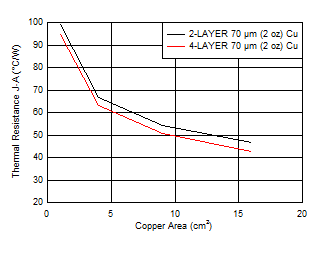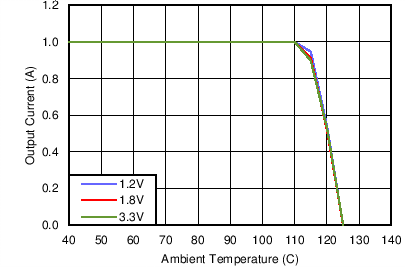SNVS874E August 2012 – September 2021 LMZ20501
PRODUCTION DATA
- 1 Features
- 2 Applications
- 3 Description
- 4 Revision History
- 5 Pin Configuration and Functions
- 6 Specifications
- 7 Detailed Description
- 8 Application and Implementation
- 9 Power Supply Recommendations
- 10Layout
- 11Device and Documentation Support
- 12Mechanical, Packaging, and Orderable Information
Package Options
Refer to the PDF data sheet for device specific package drawings
Mechanical Data (Package|Pins)
- SIL|8
Thermal pad, mechanical data (Package|Pins)
Orderable Information
8.2.1.5 Maximum Ambient Temperature
As with any power conversion device, the LMZ20501 will dissipate internal power while operating. The effect of this power dissipation is to raise the internal temperature of the converter above ambient. The internal die temperature is a function of the ambient temperature, the power loss, and the effective thermal resistance RθJA of the device and PCB combination. The maximum internal die temperature for the LMZ20501 is 125°C, thus establishing a limit on the maximum device power dissipation and, therefore, load current at high ambient temperatures. Equation 3 shows the relationships between the important parameters.

It is easy to see that larger ambient temperatures and larger values of RθJA will reduce the maximum available output current. As stated in the Semiconductor and IC Package Thermal Metrics Application Report, the values given in the Thermal Information table are not valid for design purposes and must not be used to estimate the thermal performance of the application. The values reported in that table were measured under a specific set of conditions that never obtain in an actual application. The effective RθJA is a critical parameter and depends on many factors such as the following:
- Power dissipation
- Air temperature
- PCB area
- Copper heatsink area
- Air flow
- Adjacent component placement
A typical curve of maximum load current versus ambient temperature is shown in Figure 8-4. This graph assumes a RθJA of 44°C/W and an input voltage of 5 V.
 Figure 8-3 RθJA Versus
Copper Board Area
Figure 8-3 RθJA Versus
Copper Board Area Figure 8-4 Maximum Output Current
Versus Ambient Temperature, RθJA = 44°C/W, VIN = 5
V
Figure 8-4 Maximum Output Current
Versus Ambient Temperature, RθJA = 44°C/W, VIN = 5
V